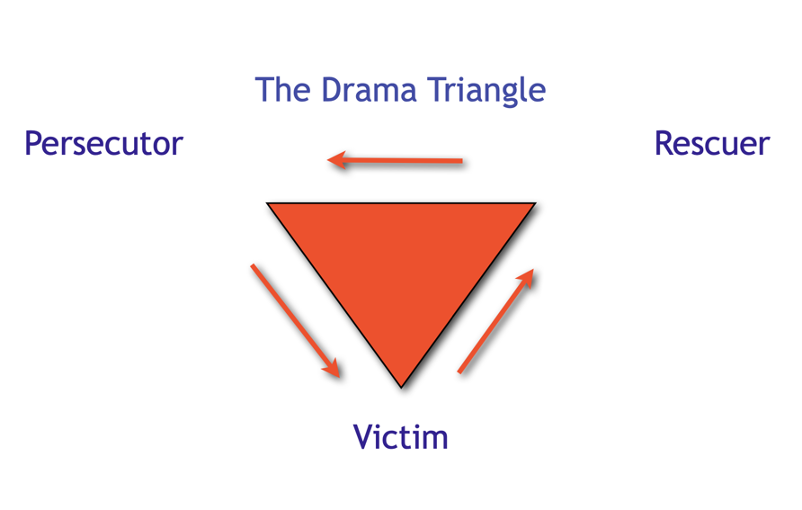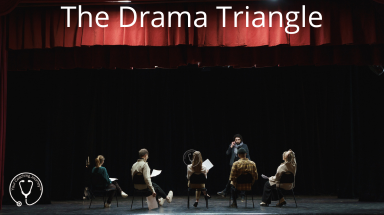Prefer to listen?
This blog post forms the basis of a podcast on our new coaching model, which you can listen to here.
What Is The Drama Triangle?
This is a model that comes from the field of Transactional Analysis (TA). It’s about relationship dynamics and interactions. The Drama Triangle is a useful model to think about in terms of how the coachee shows up and presents the situation that they’re facing and the different people or elements to their scenario.
There are three characters, or roles in this model:
- persecutor,
- victim,
- rescuer.
And there is a dynamic represented in the way in which it’s drawn. When you look at the drama triangle and it’s presented as a triangle, it’s always inverted, with the point, pointing down. The persecutor and the rescuer sit at the top of the triangle, and then lower down, you have the victim. And that’s because the rescuer and the persecutor both see themselves as better than, or one up from the victim who sees themselves as one down from the persecutor and the rescuer.
Transactional Analysis is really about how we view our place in the world and this is a visual representation of that idea of being one down or one up from someone else.

Let’s look briefly at each role:
The Persecutor:
This model is really a reimagining of the parent-adult child model, also from TA. It’s a simplified version, because there you have six different elements. In this, you only have three. The persecutor is like the controlling parent from that model.
They’re very controlling, blaming, critical, can be a bit oppressive, tend to be quite angry. They tend to criticise and blame other people, use threats and punishment as a way of controlling others. They tend to think that they’re always right and tend to be quite demeaning of those that they see as one down, as weaker, more inferior than them.
The benefit for them in being in that persecutor role is that they keep control of things and they are seen as assertive and superior.
It might be a way of them actually avoiding having to face their own vulnerability and their own emotions, so it’s a way of keeping control of themselves as well as of other people.
The Victim*:
Potentially because of the way other people are treating them, feels oppressed, helpless, hopeless, powerless and maybe ashamed. They may feel they’re unable to make decisions. They see themselves as ‘less than’ and incapable in some way. They tend to seek out sympathy from someone else, perhaps a rescuer. They may be avoiding their own responsibilities in whatever circumstance they’re in and can often feel mistreated by the persecutor or by the situation.
They’re looking for someone else to solve the problem for them. And obviously this means, in terms of secondary gain for them, that they get some attention from whoever it is they’re going to talk to or who is taking care of them.
With any of these things, that’s a drama being played out, and often repeated. So there’s a script to it, but if everyone’s happy with the script and gets what they need from it, it can be okay and not dysfunctional. It might just be the way they both got something they’re looking for. Obviously, if that was perpetuated and it just became the way that they lived all the time, then that could be or become quite dysfunctional.
* It’s important here to say that when we’re talking about relationship dynamics and ‘dramas’ or interactions playing out, and that they really should be differentiated from abusive situations. That’s an entirely separate situation, although there might be some crossover the language that we use. We are not victim blaming, or rationalising bullying or abusive behaviour. We know that there are actual victims in the world and there are real persecutors. And we know that not everyone has control of their situation. But for the most part, when we talk about coaching, we are working with people who are capable, resourceful, whole people that can do something to influence their situation. They have choices that they can make in their world that will influence the way that the drama is playing out.
The Rescuer:
The rescuer feels an overwhelming need to help others. They’re the people-pleasers of the world, often to their own detriment, their needs aren’t met, because they’re busy meeting the needs of everyone else. They do the caring, and they enable the victim. (The victim, of course enables the rescuing.) Rescuers are really supportive and feel guilty if they’re not being supportive.
The whole concept of people-pleasing comes from transactional analysis, so it all feeds in together. Rescuers will quite often offer help when it hasn’t been asked for, and they get some sense of self-worth from feeling needed.
From a well-being perspective, they’re obviously putting themselves under pressure by taking on other people’s roles, other people’s work, responsibilities, problems.
The payoff for them is that they can avoid thinking too much about themselves in terms of maybe needs that aren’t being met and emotions that aren’t being addressed. It’s a way of avoiding something or maybe deriving a sense of worth from their endeavours.
Understanding The Drama Dynamic
In transactional analysis, they talk about ‘strokes’. The transaction is a stroke, given or received. That ‘stroke’ or attention between two people is the payoff. Sometimes that’s quite negative attention, but negative attention is better than no attention at all. If you think about people pushing someone else’s buttons to get a reaction, that’s a stroke. It’s a negative stroke, but it’s a stroke nonetheless. We all so crave that interaction and someone noticing us.
When individuals describe their situations, interactions, or ‘dramas’, there is certainly an interaction happening, but to a certain extent, how they’re perceiving things is the important element, rather than the reality. It’s important to explore the assumptions that are being ,ade, and the different perspectives you could take on the situation, which, of course, coaching is really beneficial for.
Is the persecutor always a person?
It doesn’t have to be, it could be the scenario. It could be that they, in their role, are overworked, and overwhelmed with that work. They’re not coping, so they could see themselves as the victim of the situation. There wouldn’t be a person involved necessarily.
Does the ‘victim’ always need rescuing?
No. We’ve already mentioned that often the rescuer will offer, or rush in to rescue, without being asked, or even needed.
How permanent are these roles?
They’re very fluid, actually. And they can move around within the same conversation.
Let’s imagine you’ve got a manager who’s got a direct report that comes to them and this is the (very simplified) interaction:
Team member: “I’m really struggling with this. I need your help”. (victim role)
Manager: “Okay, what’s the problem?”
Team member explains the problem.
Manager: “Well, why don’t you do this?” (rescuer role)
Team member: “No, that’s not going to work because of xyz” (victim role)
Manager: “What about if you try abc then? (rescuer role)
Team member: “Well, that’s not going to work either.” (victim role)
Manager: “Well, how about if you do this? (rescuer role)
Team member: “Well, that’s not going to work. Oh, you’re rubbish at this. I’ll come to you for help and you no help at all.” **
**In this scenario, the rescuer has actually turned into the victim, and the victim has become the persecutor because they’re blaming the rescuer for not being able to help. So suddenly we’ve got someone, the manager, feeling foolish and de-skilled by the victim.
And that’s a drama, or the game being played out.
What are some of the other changes that we might see?
On the one hand, in the victim – persecutor dynamic, the person in the persecutor role, who blames the victim could escalate that behaviour. Or, on the other hand the victim could retaliate and reverse the roles.
If a rescuer, is talking to someone who’s presenting as a victim, who may isn’t taking their advice, the rescuer could then start to become the persecutor and say, “Well, you’re not doing as I said” and they could start to blame the victim for not taking responsibility, becoming the persecutor.
So it can be quite fluid.
The Drama triangle In The Coaching Room
In the coaching room, we probably won’t get clients who present themselves as the persecutor. That would be highly unlikely. But, in the terms of the way they describe their behaviour, you might see them as the persecutor, as being quite controlling. Tom had someone who, in a workshop rather than a coaching situation presented as very controlling.
“We were talking about using more of a coaching approach in terms of leadership. He said, ‘I can’t do that. These people can’t think for themselves. They’re just one up from the dole queue. They can’t do any thinking’.
And that was his approach to his team. So, of course, they’re never going to do the thinking because he’s not giving them freedom to do it. He was almost displaying rescuing behaviour because he was saying ‘they’re not capable. I need to think for them’, but at the same time blaming them for being like that. So, a combination of persecutor and rescuer. And that may be one way that the persecutor shows up in a scenario”.
NOTE: We don’t think it’s helpful to describe a client as or tell them that they are the persecutor in this drama triangle. (you may even prefer to use the parent-adult-child model as it is a bit more of a gentle language). But you can present the model and discuss the dynamics and where they think they might be, or how the situation might be playing out.
We will have people showing up in the coaching room as ‘victim’, and that might be in terms of asking us for the answers or just in how they are explaining the situation. Again, it’s not helpful to describe them as the victim, but we can recognise that that behaviour seems like victim behaviour and allow this to inform out coaching.
The most useful or the most common way of using the Drama Triangle is when you’re seeing a rescuer and someone perhaps that’s overwhelmed, they’ve just got too much work going on and they’re taking on everyone else’s work. The people pleasers. Being able to present this triangle just as an illustration and say, these are the three characters, where do you see yourself? They will most likely recognise that they’re in the rescuer mode. And being, or not being, the rescuer is something that’s quite often talked about these days and is quite common terminology in management circles. Obviously, the drama triangle is more complex than just talking about rescuers, but I think it’s probably the most common place that you’re going to present the drama triangle and use it to inform our discussion in the coaching room
As all coaching is, it’s about raising awareness around the situation.
It’s also really useful for coaches to think about in terms of their interactions in the coaching room. We don’t want to be giving advice because that’s rescuing behaviour. The victim will be happy for you to give advice, on the whole, they might not follow it, but they’ll be quite happy for you to solve the problem for them. But it’s not empowering for them. It doesn’t lift them up in any way for you to give them the answer. But the payoff for the victim is they don’t have to do the cognitive effort of thinking about anything. They just get the answer given to them. And for the coach, if you’re a rescuer, you will feel very righteous, very all’s well with the world because you’ve managed to solve the problem. That can become a co-dependent. We really want to get rid of the ‘drama’ in the coaching room and to be having adult-to-adult conversations. But sometimes that’s about noticing what you notice in the way that someone shows up. If they are presenting themselves as a victim, asking them open questions that invite them to think about the situation in a way that allows them to lift themselves up and find their own answers and to know that they’re capable of finding their answers. The coaching room should be a very empowering place because we’re trying to invite people that are presenting as a victim to think for themselves.
The Empowerment or Winner’s Triangle
In the Drama Triangle the persecutor is seen as evil, the rescuer is seen as heroic, and the victim is seen as helpless. We often see people talking about the opposite of the drama triangle, often known as the empowerment or the winner’s triangle, where instead of a ‘victim’ being seen as helpless, they are seen as vulnerable and need lifting up to feel more empowered, the persecutor probably isn’t evil, they may be just being assertive, and we just need to think about that in a different way. And the rescuer, rather than heroic is a resource, or supporter.
Yes, the drama triangle raises awareness, and it can be useful and helpful to understand, perhaps to take some responsibility around our own role within those dynamics, but we’re ultimately aiming to step outside of the drama, outside of the triangle, to get rid of those characters altogether, so it becomes people talking to people.
Coaching is a great place to explore the dynamics of relationships and situations, where someone can explain how they’re thinking or feeling about it. And sometimes, coaching uncovers that it’s faulty thinking. Sometimes none of it is actually true, it’s a story made up in their head because they’ve had one interaction with someone, or maybe someone has ignored them one morning. We can very easily go to that place of ‘enemy action’ when there isn’t any there at all. We can also go to that place of feeling helpless when what we really need to do is to think through our problem. Obviously, coaching is a great environment in which to do some proper thinking, to slow everything down and think properly about it, and to raise ourselves up to be capable.
And that’s why TA fits beautifully with transformational coaching because it’s multi-layered, and nuanced, and flexible. It has its different uses, relationships could be family relationships, or workplace relationships, anywhere where people are interacting with other people. And if we can use coaching to help get rid of the drama and get back to talking to people properly, that would be good.
To find out more about our Doctors’ Transformational Coaching Diploma click through here



